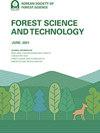Effects of the forest industry on the South Korean national economy: evidence from an Input-Output analysis based on the special classification for the forest industry
IF 2.2
Q2 FORESTRY
引用次数: 2
Abstract
Abstract Following the Fourth Industrial Revolution, the forest industry sector now combines cutting-edge technology with other industries. Hence, the Special Classification for the Forest Industry was established to clearly define the scope of the forest industry. Therefore, we reclassify the 2018 input-output table of the Bank of Korea based on the Special Classification of the Forest Industry. Specifically, we calculate the proportion of the forest industry that contributes to the products and services of each industry and divide them into forest and non-forest industry sectors to create the input-output table of the forest industry. We find that a direct and indirect production inducement effect of KRW 193.4 million occurs when KRW 100 million is invested in the forest industry. The import inducement coefficient is 0.221 and the value-added inducement coefficient is 0.779. In the labor sector, the total workers inducement coefficient is 12.9 and the employee inducement coefficient is 8.5.森林产业对韩国国民经济的影响:基于森林产业特殊分类的投入产出分析证据
在第四次工业革命之后,森林工业部门现在将尖端技术与其他行业结合起来。为此,制定了《森林工业专项分类》,明确界定了森林工业的范围。因此,我们根据《森林产业特别分类》对韩国银行2018年投入产出表进行重新分类。具体来说,我们计算了林业对各个行业的产品和服务的贡献比例,并将其划分为林业和非林业部门,创建了林业投入产出表。我们发现,在森林产业投资1亿韩元时,产生了1.934亿韩元的直接和间接的生产诱导效应。进口诱导系数为0.221,增值诱导系数为0.779。在劳动部门,总工人诱导系数为12.9,雇员诱导系数为8.5。
本文章由计算机程序翻译,如有差异,请以英文原文为准。
求助全文
约1分钟内获得全文
求助全文

 求助内容:
求助内容: 应助结果提醒方式:
应助结果提醒方式:


